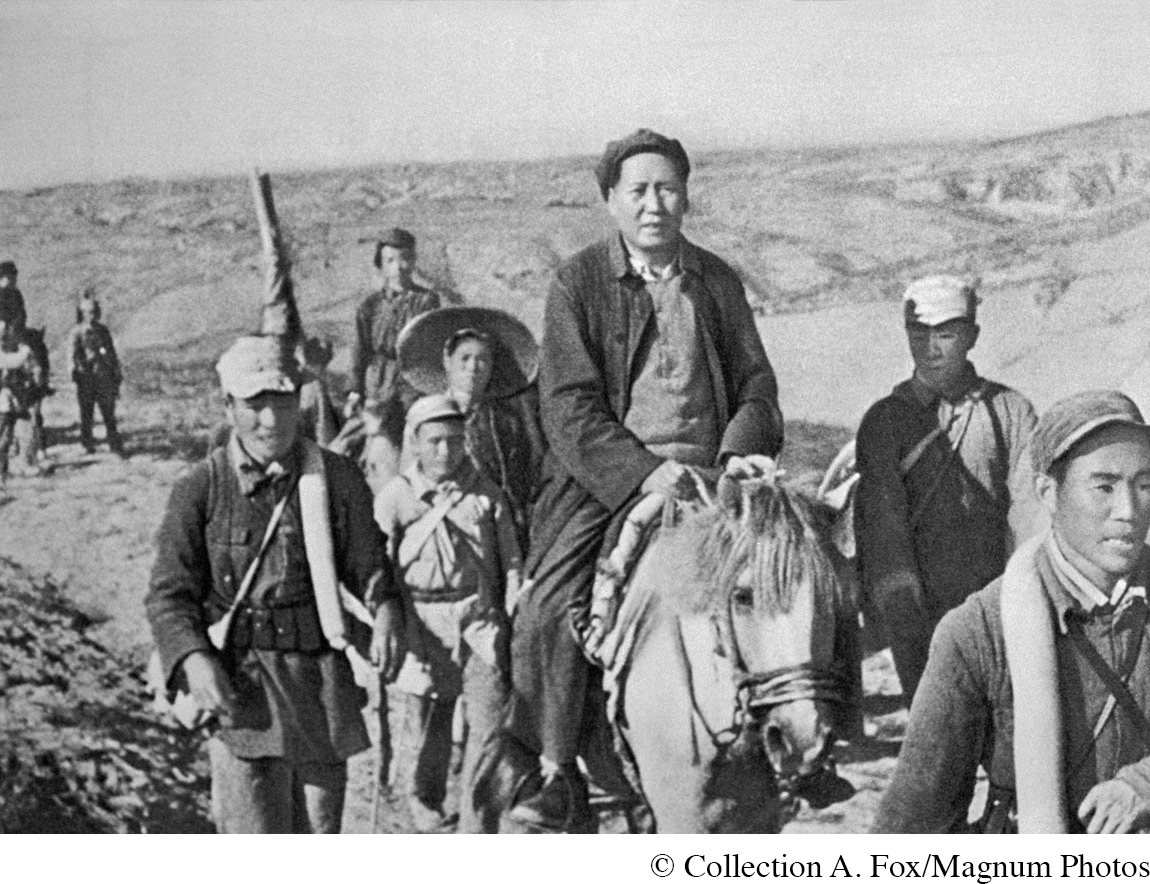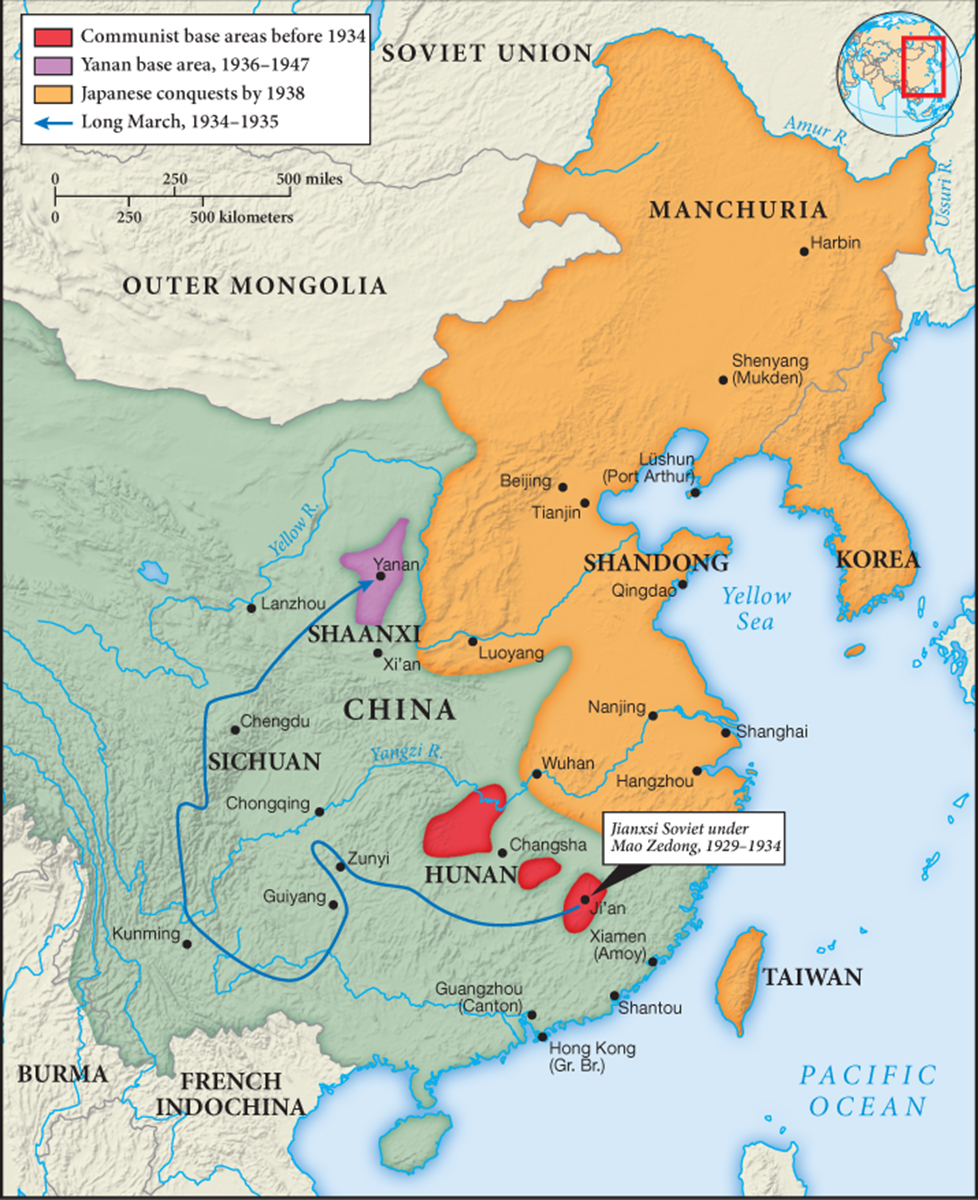China: A Prolonged Revolutionary Struggle
Communism triumphed in the ancient land of China in 1949, about thirty years after the Russian Revolution, likewise on the heels of war and domestic upheaval. But that revolution, which was a struggle of decades rather than a single year, was far different from its earlier Russian counterpart. The Chinese imperial system had collapsed in 1911, under the pressure of foreign imperialism, its own inadequacies, and mounting internal opposition (see “Reversal of Fortune: China’s Century of Crisis” in Chapter 19). Unlike in Russia, where intellectuals had been discussing socialism for half a century or more before the revolution, in China the ideas of Karl Marx were barely known in the early twentieth century. Not until 1921 was a small Chinese Communist Party (CCP) founded, aimed initially at organizing the country’s minuscule urban working class.
What was the appeal of communism in China before 1949?
Over the next twenty-eight years, that small party, with an initial membership of only sixty people, grew enormously, transformed its strategy, found a charismatic leader in Mao Zedong, engaged in an epic struggle with its opponents, fought the Japanese heroically, and in 1949 emerged victorious as the rulers of China. That victory was all the more surprising because the CCP faced a far more formidable foe than the weak Provisional Government over which the Bolsheviks had triumphed in Russia. That opponent was the Guomindang (GWOH-mihn-dahng) (Nationalist Party), which governed China after 1928. Led by a military officer, Chiang Kai-shek, that party promoted a measure of modern development (railroads, light industry, banking, airline services) in the decade that followed. However, the impact of these achievements was limited largely to the cities, leaving the rural areas, where most people lived, still impoverished. The Guomindang’s base of support was also narrow, deriving from urban elites, rural landlords, and Western powers.

Mao Zedong and the Long March An early member of China’s then-minuscule Communist Party, Mao rose to a position of dominant leadership during the Long March of 1934–1935, when beleaguered communists from southeastern China trekked to a new base area in the north. This photograph shows Mao on his horse during that epic journey of some 6,000 miles. (© Collection A. Fox/Magnum Photos)
Chased out of China’s cities in a wave of Guomindang-inspired anticommunist terror in 1927, the CCP groped its way toward a new revolutionary strategy, quite at odds with both classical Marxism and Russian practice. Whereas the Bolsheviks had found their primary audience among workers in Russia’s major cities, Chinese communists increasingly looked to the country’s peasant villages for support. Thus European Marxism was adapted once again, this time to fit the situation of a mostly peasant China. Still, it was no easy sell. Chinese peasants did not rise up spontaneously against their landlords, as Russian peasants had. However, years of guerrilla warfare, experiments with land reform in areas under communist control, and the creation of a communist military force to protect liberated areas slowly gained for the CCP a growing measure of respect and support among China’s peasants. In the process, Mao Zedong, the son of a prosperous Chinese peasant family and a professional revolutionary since the early 1920s, emerged as the party’s leader.
To recruit women for the revolution, communists drew on a theoretical commitment to the liberation of women and in the areas under communist control established a Marriage Law that outlawed arranged or “purchased” marriages, made divorce easier, and gave women the right to vote and own property. Early experiments with land reform offered equal shares to men and women alike. Women’s associations enrolled hundreds of thousands of women and promoted literacy, fostered discussions of women’s issues, and encouraged handicraft production, such as making the clothing, blankets, and shoes that were so essential for the revolutionary forces. But resistance to such radical measures from more traditional rural villagers, especially the male peasants and soldiers on whom the communists depended, persuaded the communists to modify these measures. Women were not permitted to seek divorce from men on active military duty. Women’s land deeds were often given to male family heads and were regarded as family property. Female party members found themselves limited to work with women or children.
It was Japan’s brutal invasion of China that gave the CCP a decisive opening, for that attack destroyed Guomindang control over much of the country and forced it to retreat to the interior, where it became even more dependent on conservative landlords. The CCP, by contrast, grew from just 40,000 members in 1937 to more than 1.2 million in 1945, while the communist-led People’s Liberation Army mushroomed to 900,000 men, supported by an additional 2 million militia troops (see Map 21.2). Much of this growing support derived from the vigor with which the CCP waged war against the Japanese invaders. Using guerrilla warfare techniques learned in the struggle against the Guomindang, communist forces established themselves behind enemy lines and, despite periodic setbacks, offered a measure of security to many Chinese faced with Japanese atrocities. The Guomindang, by contrast, sometimes seemed to be more interested in eliminating the communists than in actively fighting the Japanese. Furthermore, in the areas it controlled, the CCP reduced rents, taxes, and interest payments for peasants; established literacy programs for adults; and mobilized women for the struggle. As the war drew to a close, more radical action followed. Teams of activists encouraged poor peasants to “speak bitterness” in public meetings, to “struggle” with landlords, and to “settle accounts” with them.

Map 21.2 The Rise of Communism in China Communism arose in China at the same time as the country was engaged in a terrible war with Japan and in the context of a civil war with Guomindang forces.
Thus the CCP frontally addressed both of China’s major problems—foreign imperialism and peasant exploitation. It expressed Chinese nationalism as well as a demand for radical social change. It gained a reputation for honesty that contrasted sharply with the massive corruption of Guomindang officials. It put down deep roots among the peasantry in a way that the Bolsheviks never did. And whereas the Bolsheviks gained support by urging Russian withdrawal from the highly unpopular First World War, the CCP won support by aggressively pursuing the struggle against Japanese invaders during World War II. In 1949, four years after the war’s end, the Chinese communists swept to victory over the Guomindang, many of whose followers fled to Taiwan. Mao Zedong announced triumphantly in Beijing’s Tiananmen Square that “the Chinese people have stood up.”

